What is prostatic disease? We will analyze the causes, diagnosis and treatment methods in the article of a doctor, a urologist with 28 years of experience.
Disease definition. Cause of disease
ProstatitisIs an inflammatory process of the prostate tissue, accompanied by pain in the lower back, perineum or pelvis, as well as disturbances in the work of the lower urinary tract.
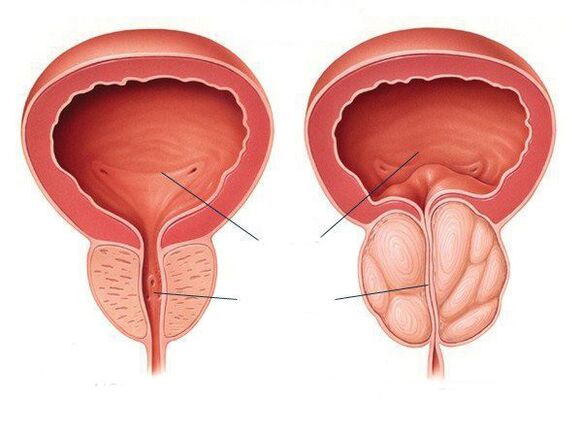
Prostate (prostate) refers to the male reproductive system. It is located in front of the rectum, below the bladder, and surrounds the urethra (urethra). That is why when the prostate becomes inflamed, it puts pressure on the urethra, which in turn leads to various problems with urination. The main function of the prostate gland is to produce secretions (fluids), which are part of semen, and to liquefy it to ensure normal sperm motility.
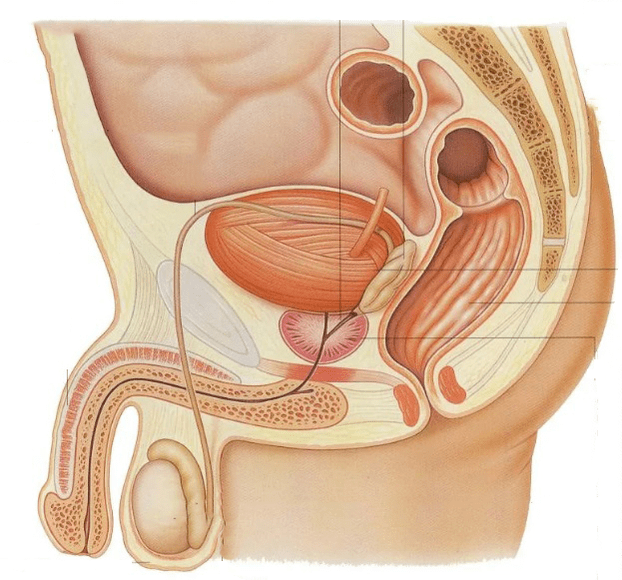
Pathological conditions of the prostate, such as cancer or benign hyperplasia, are more common in older patients. Prostatitis differs in that it affects men of all ages, but the disease most commonly occurs in men of reproductive age (between 8 and 35% of cases).
Prostatitis occurs most often in the practice of a urologist. It can occur suddenly (acute) or gradually, and its manifestations are continuous and long-lasting (chronic). The chronic form is much more common than the acute form. Chronic prostatitis ranks fifth among the 20 major urological diagnoses.
Prostatitis may be an independent disease or in association with benign prostatic hyperplasia and prostate cancer. In recent years, the incidence of prostatitis in men has decreased gradually: if in 2012 the incidence rate was 275 per 100 thousand population, in 2017 the primary incidence rate was 203 per 100 thousand population.
The reasons for the development of prostatitisare bacterial (infectious) and non-bacterial (non-infectious).Infectious prostatitisMost common in men under the age of 35. Usually, this form of the disease is caused by gram-negative microorganisms, especially enterobacter, E. coli, serosa, pseudomonas and proteus, as well as sexually transmitted infections, such as gonorrhea, Chlamydia, etc. v. Very rarely, prostatitis can occur due to mycobacterium tuberculosis. In chronic bacterial prostatitis, the pathogen spectrum is broader and may include atypical pathogens. It should be remembered that chronic bacterial prostatitis is a polygenic disease, that is, it can be caused by a number of causes.
Factors that contribute to the development of inflammationin the prostate:
- sexually transmitted diseases;
- immunodeficiency states;
- prostate biopsy;
- invasive manipulations and manipulations;
- Lifestyle;
- diarrhea, constipation;
- same-sex relations;
- frequently change sexual partners;
- sedentary lifestyle, etc. v.
Chronic non-bacterial prostatitis viwas diagnosed in patients who complained of chronic pain in the prostate area, while an infectious (bacterial) agent was not found in them. Despite many studies, the causes of this type of chronic prostatitis are not fully understood, however, there are several factors that can cause its development:
- increased pressure on the prostate gland;
- muscle pain in the pelvic region;
- emotional disturbances;
- Autoimmune disorders (antibodies that are thought to fight infection, sometimes for some reason attack the cells of the prostate gland);
- physical activity;
- irregular sex life;
- weight lifting, etc. v.
In some cases, prostatitis can occur after vasectomy procedures such as urethral catheterization or cystoscopy, as well as after a transrectal prostate biopsy.
Although the true prevalence of various types of prostatitis is not well established, the following data are provided:
- acute bacterial prostatitis accounts for about 5-10% of all cases of prostatitis;
- chronic bacterial prostatitis - 6-10%;
- chronic non-bacterial prostatitis - 80-90%;
- prostatitis, including prostatitis (nervous dysfunction of the prostate gland) - 20-30%.
If you see similar symptoms, consult your doctor. Do not self-medicate - it will be dangerous to your health!
Symptoms of Prostatitis
All forms of inflammationProstate gland, in addition to being asymptomatic, is united by the presence of the following symptoms:
- pain in the lower back;
- discomfort with bowel movements;
- pain in the perineum or pelvis;
- disorders in the work of the lower urinary tract.
The main symptoms of the lower urinary tract in the presence of prostatitis:
- frequent urination;
- difficulty urinating, i. e. weak flow and the need to "push";
- burning or increased pain when urinating.
In men diagnosedacute bacterial prostatitisPelvic pain and urinary tract symptoms such as increased urination and urinary retention occur. This can lead to the development of systemic manifestations such as fever, chills, nausea, vomiting and malaise. Acute bacterial prostatitis is characterized by a clear onset of disease with a vivid clinical picture. This is a serious disease.
Men diagnosedchronic bacterial prostatitisrecorded symptoms of cyclic nature, increasing and decreasing. With an exacerbation, pain and discomfort are noted. Pain is felt mainly at the base of the penis, around or above the anus. Alternatively, pain can occur just above the pubic bone or in the lower back, spreading to the penis and testicles. It also becomes painful to have a bowel movement. Sometimes signs of infection of the lower parts of the urinary system develop: burning pain and frequent, frequent urination. These symptoms can be confused with those of acute bacterial prostatitis, but they are usually sudden in onset, with chills, fever, weakness, pain all over the body, in the lower back as well as in the chest. genitals, frequent and painful urination, pain with ejaculation. If you notice such symptoms, you need to urgently see a doctor.
If standard modern examination methods do not determine that chronic pain is due to a pathological process in the prostate gland, then we are dealing with chronic nonbacterial prostatitis, also known as prostatitis.chronic pelvic pain syndrome(the term has been in use since 2003). In the presence of chronic pelvic pain syndrome, a man's quality of life is significantly reduced, as this syndrome sometimes leads to various psychological and sexual disorders:
- increased fatigue;
- feel helpless;
- erectile dysfunction;
- painful ejaculation;
- pain after intercourse, etc. v.
In chronic nonbacterial prostatitis/chronic pelvic pain syndrome, there is persistent discomfort or pain in the lower back, more often at the base of the penis and around the anus, for at least 3month. Localized pain sensation in one "target organ" or several pelvic organs. Usually, with this form of prostatitis, the pain is localized to the prostate (46%).
In chronic prostatitis, sexual dysfunction has several features. First, all components of a man's sexual (sexual) function are disturbed to varying degrees: libido, erection, ejaculation. Second, sexual dysfunction mainly occurs in people with a long history of the disease (more than 5 years). Third, sexual dysfunction is often the primary reason to seek medical attention.
Erectile dysfunction is noted by 30% of patients with chronic prostatitis, largely due to psychological factors - a pathetic perception of the disease.
Symptoms of prostatitis occur at least once in a lifetime in 50% of men.
Pathogenesis of prostatitis
The mechanism of development of prostatitis is multifaceted and very complex. Many factors are involved in its development. Most cases of acute bacterial prostatitis are caused by a series of processes triggered by ascending urethral infection or endostatic reflux (backflow of urine).
Microbial entry into the prostate can be either ascending (through the urethra) or via the lymphatic route. Diarrhea and constipation associated with impaired rectal barrier function have been implicated as provoking factors for chronic prostatitis. However, the mechanism of microbial entry into the prostate gland has not been clearly established.
Urinary disorders with prostatitis can be caused by:
- increase the tone of the prostatic urethral smooth muscle by increasing the activity of adrenergic receptors;
- prostatic hypertrophy or urethral stricture, resulting in turbulent urine flow, bladder outlet obstruction, and intravesical reflux.
In the future, there is a violation of the drainage of the ducts of the prostate gland, stagnation of secretions of the prostate gland, edema, activation of arachidonic acid outflow, inflammation and ischemia. A vicious cycle of pathological changes is formed.
Classification and stages of development of prostatitis
There are 4 main types (types) of prostatitis.
- Acute bacterial prostatitis(type I).
- Chronic bacterial prostatitis(class II).
- Nonbacterial prostatitis syndrome/chronic prostatitischronic pelvic pain (type III). May be inflammatory (type III A) or non-inflammatory (type III B).
- Asymptomatic inflammatory prostatitis.Histological prostatitis is determined by prostate biopsy (type IV).
Chronic bacterial prostatitisUnlikeSpice,manifests as recurrent exacerbations with or without episodes of complete remission between them. Symptoms are usually less severe than those of acute prostatitis.
Classification of the US National Institutes of Health. . .
- Type I(acute bacterial prostatitis) - acute infection of the prostate gland: the symptoms of the disease come on suddenly. Chills, fever, pain all over the body, weakness, pain in the lower back and genital area, frequent urination, pain, pain with ejaculation. Potential symptoms of acute bacterial prostatitis include blood in the urine and/or semen. It is rare. It is effectively treated with antibiotics.
- Type II(chronic bacterial prostatitis) - a chronic or recurrent infection of the prostate gland: the symptoms are the same as in acute prostatitis, but appear more gradual and less obvious. Some antibiotic therapy may be required.
- Type III(chronic nonbacterial prostatitis and chronic pelvic pain syndrome): no evidence of infection.
- III One kind: presence of leukocytes in ejaculation / prostate secretion / third of urine obtained after prostate massage.
- Class III: no leukocytes in ejaculate / prostate secretion / third of urine obtained after prostate massage. Pain in the lower back and genital area, frequent urination, difficulty urinating (usually at night), burning or painful urination and ejaculation. Represents about 90% of all cases of prostatitis. There is no known cause or clinically proven treatment.
- Type IV(asymptomatic inflammatory prostatitis): Occasionally increased white blood cell count. No treatment needed. Detected on prostate biopsy.
The boundaries between different forms of prostatitis are blurred.
Complications of prostatitis
With inflammatory lesions of the prostate gland, neighboring organs participate in the pathological process: the seminal vesicles, Cooper's glands, seminal vesicles and posterior urethra. Infection can invade the prostate gland and surrounding organs simultaneously.
Inflammation of the blisters- inflammation of the seminal vesicles. The pain is localized in the groin area and deep in the pelvis, spreading to the sacrum. The pain is usually unilateral, as both seminal vesicles are affected to varying degrees. Inflammation of the blisters may be asymptomatic. The patient's only complaint may be the presence of blood in the semen. Periodic pyuria (pus in the urine) and pyuria (pus in the ejaculate) were also reported.
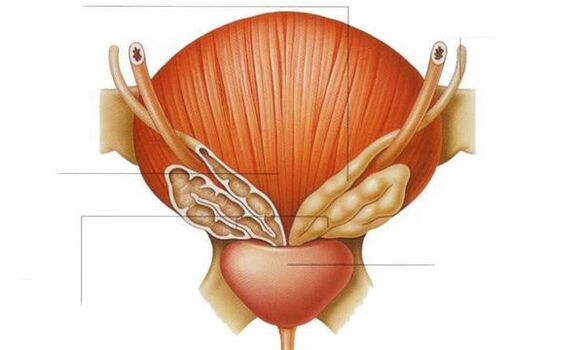
Posterior urethritis, lacrimal sac (inflammation of the seminal vesicles). . . With prostatitis, the inflammation invades the tuberous capsule, which is caused by the proximity of the prostate gland to the excretory duct.
Prostate abscess.Pathogens that cause prostatitis can also cause prostate abscesses. This is a severe (bacterial) infection, accompanied by weakness, fever, chills, and sweating. In some cases, impaired consciousness and delirium were observed. The patient needs to be hospitalized.
Hardening of the prostate gland (fibrosis).This is a late complication of prostatitis, which is based on the replacement of prostate tissue by scars (connective tissue degeneration, i. e. sclerosis), leading to a shrinking, reduced size of the prostate gland. size and completely lost function. As a rule, sclerotic symptoms develop long after the onset of the inflammatory process in the prostate gland.
Prostate cyst.These formations can contribute to stone formation in the prostate gland. The presence of infection in the cyst can lead to a prostate abscess. It is not difficult to diagnose prostate cysts with ultrasound. They can also be detected with a digital rectal exam.
Prostate stone.They are quite popular. The causes of this disease are not fully understood, but most experts agree that they arise from a prolonged inflammatory process in the prostate gland. Stones are single and multiple, 1 to 4 mm in diameter. Large stones are rare. The stones block the gland, so bile is trapped in it, the gland is overdilated and separate cysts form, from which infection enters. Patients with prostate stones face constant dull pain in the perineum. Pain spreads down to the glans penis and makes frequent urination difficult and painful.
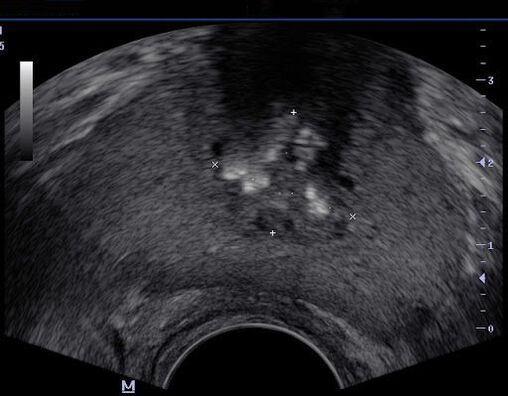
Dry.Chronic long-term prostatitis mainly reduces sperm motility, rendering them completely immobilized. One of the consequences is a violation of their production, the formation of immature spermatozoa of an abnormally changed shape (and less numerous than before).
Ejaculation disorder.Prostatitis in any form causes sexual dysfunction. At first, the patient has to face premature ejaculation, normal erection, then weakening, the level of orgasm gradually decreases. Prolonged persistence of chronic prostatitis contributes to decreased male sex hormone production and decreased libido.
Erectile dysfunction.The relationship between chronic prostatitis/chronic pelvic pain syndrome and erectile dysfunction has been described. This disorder is especially painful for men.
Diagnosis of prostatitis
The appearance of the first signs of prostatitis requires immediate medical attention. The urologist will rule out many diseases with similar manifestations, and determine the type (type) of the disease. Before choosing a treatment, a specialist will conduct the necessary examinations and recommend undergoing an evaluation test.
Questions a doctor can ask
At the appointment, the doctor will definitely specify: the duration of the clinical manifestations of the disease, the location and nature of the pain, for example, in the perineum, scrotum, penis and inner thighs; change in the nature of semen (presence of pus and blood).
At the front desk, the urologist will offer to fill out special questionnaires, one of which is an indicator of the symptoms of chronic prostatitis.
The patient should ask the doctor questionsabout what tests and research will need to be done, how to prepare for them, the treatment he intends to prescribe and where I can get more information about the disease.
Chronic bacterial prostatitis is diagnosed when symptoms persist for at least three months.
The survey will include:
- Digital rectal examination of the gland to determine the degree of prostate enlargement and its consistency.
- Examination of prostate secretions, urine, and/or ejaculation.
- Identify urogenital infection.
- Ultrasound examination of the urinary system (kidneys, prostate, bladder with residual urine).
- Urodynamic studies.

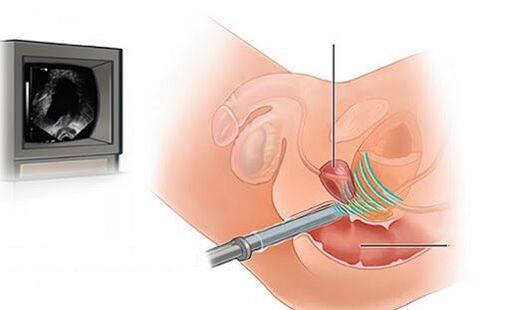
In the case of acute bacterial prostatitis, a swollen and painful prostate can be found on a digital rectal exam. Prostate massage is contraindicated because it can lead to sepsis and sepsis.
The most important study in the examination of patients with acute bacterial prostatitis is the culture of prostate secretions. For the classification of chronic prostatitis, quantitative culture and microscopy of urine and prostate secretions obtained after prostate massage remain important methods.
Androflor - a comprehensive study of microbiocenosis of the urogenital tract in men by PCR. Allows you to determine the qualitative and quantitative composition of the microflora. It is used for the diagnosis and control treatment of infectious and inflammatory diseases of the genitourinary system.
After determining the cause of the disease, the doctor will prescribe a course of treatment. It must be remembered that standard methods can detect infection only in 5-10% of cases, which eventually leads to prostatitis.
What is the relationship between prostatitis, prostate-specific antigen (PSA) and prostate cancer?
Measurement of total and free PSA levels in prostatitis provides no additional diagnostic information. It is known that in 60 and 20% of patients with acute and chronic bacterial prostatitis, the level of prostate-specific antigen (PSA) is increased, respectively. After the end of treatment, PSA levels decreased in 40% of patients. PSA is not considered a specific marker for prostate cancer because PSA levels can be elevated in benign prostatic hyperplasia and prostatitis.
Prostatitis treatment
The leading role in the treatment of pathology is assigned to drug therapy.
Treatment with alpha1 . blockers
Alpha1 blockers are prescribed to patients who complain of difficulty urinating. These medications help ease urination and relax the muscles of the prostate and bladder. Some patients are prescribed medication to lower hormone levels, which can help shrink the gland and reduce discomfort. Muscle relaxants can help relieve pain caused by an enlarged prostate putting pressure on nearby muscles. Nonsteroidal anti-inflammatory drugs (NSAIDs) may be helpful if pain is present.
Standard antibiotic therapy in most cases does not reduce the number of recurrences of the disease, and therefore an integrated approach is often used and also prescribedauxiliary drugs: biostimulants, extracts of various plants and insects and their biological components, which may be in the form ofrectal suppositories. . . Although there is a large arsenal of drugs, the effect of using them is still insufficient.
Physiotherapy in the treatment of prostatitis
For chronic prostatitis types II, III A and III B, additional physiotherapeutic methods may be used:
- prostatic massage (prostate);
- laser therapy;
- hyperthermia by microwave and thermotherapy;
- electrical stimulation with a modulated current of the transdermal or rectal electrode;
- acupuncture (acupuncture).
The effectiveness and safety of these treatments are still being studied. Also used to treat prostatitisfolk method, For examplehirudotherapy.The effectiveness and safety of this method in the treatment of prostatitis have not been proven.
Stem cell injection
Cell therapy (stem cell injection) in the treatment of prostatitis is currently a promising technique in the early stages of development. Currently, regarding the injection of stem cells into the prostate, we can only hypothesize its mechanism, as well as experimental data obtained by individual groups of researchers.
Surgical treatment of prostatitis
The surgical method is applied only to treat the complications of prostatitis - abscess and compression of the seminal vesicles.
The treatment of chronic pelvic pain syndrome requires individual considerations. Asymptomatic prostatitis (type IV) should not be treated unless the patient is scheduled to have prostate surgery. In this case, the patient was given a course of prophylactic antibiotic therapy.
Diet and lifestyle for prostatitis
A special diet for prostatitis is not required, but eating plenty of vegetables, lean meats, and dairy products will improve bowel function. It is important to consume enough fiber, foods rich in vitamin E (wheat germ, corn oil, etc. ), sugar should be replaced with natural honey. Proper nutrition for prostatitis can improve bowel function and reduce the likelihood of recurrence or speed up recovery. You should follow a healthy lifestyle, drink more water and limit caffeine and alcohol.
Forecast. Preventive
Acute prostatitis often becomes chronic, even with prompt and adequate treatment.
It is not always possible to make a full recovery, however, with the correct therapy and following your doctor's recommendations, you can eliminate discomfort and pain. IndependenceProstatitis treatment at homecan be dangerous and lead to complications.
Not all cases of prostatitis can be identified as the cause, but there are some steps you can take to try to prevent prostatitis from occurring. Similar steps can help manage existing symptoms:
- Drink a lot of water. Drinking plenty of water leads to frequent urination, thus facilitating the removal of infectious agents from the prostate urethra.
- Empty the bladder regularly.
- Avoid irritation of the urethra. Limit caffeine, spicy foods, and alcohol.
- Reduce pressure on the prostate. Men who cycle regularly need to use a split chair to reduce pressure on the prostate area.
- Stay sexually active.



























